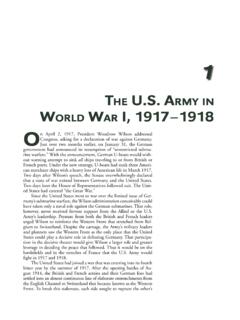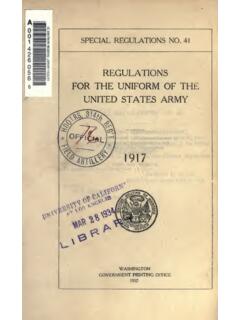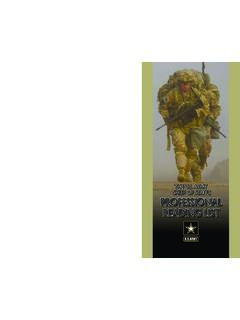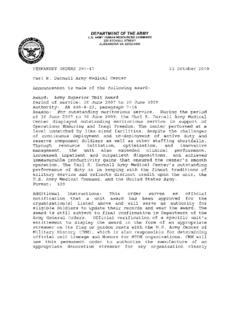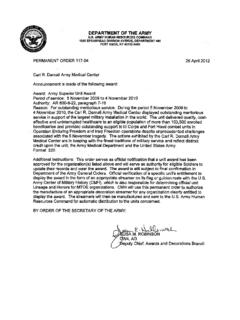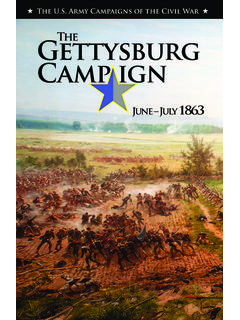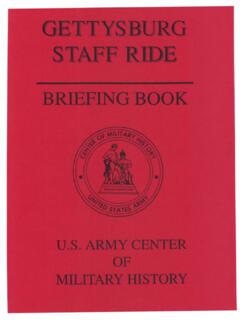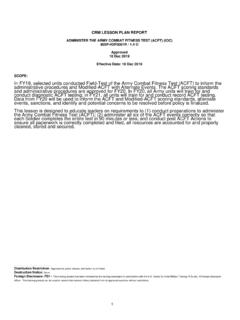Transcription of U.S. Army Field Mess Gear 1. Haversacks & Field Packs
1 army Field Mess gear 1. Haversacks & Field Packs The term haversack comes from the seventeenth century Low German word hafersach meaning a cavalry trooper's bag for horse provender, literally an oat sack. By the mid-eighteenth century the French were using the word havresac to mean a single strapped bag worn over one shoulder and used for carrying rations. This term came over into English with the same meaning (Online Etymology Dictionary). Prior to 1851 Haversacks were made of white linen in a variety of forms and sizes. Above (left), early nineteenth century haversack, and (right) a haversack from the period of the Mexican War. army Field Mess gear Prior to 1851 Haversacks were made of white linen in a variety of forms and sizes. The 1851 Haversack circa 1863. Beginning in 1851 Haversacks became black. The white linen was painted and sealed with linseed oil. The bag was approximately thirteen inches across and eleven inches deep, and had a top flap secured by a small leather strap and buckle arrangement in front.
2 Inside there was a separate white cotton or linen bag used to hold the soldier s rations. It was held in place by three buttons so that it could be removed and laundered on occasions. This pattern haversack continued in general use until the late 1870s. Above is the 1874 haversack (type 1) with a black rubberized flap and the 1874 haversack (type 2) with the drab canvas flap; both had a web shoulder strap with a Chambers Buckle. army Field Mess gear Following the Civil War, the army experimented with brace systems in 1872 and 1874. Although the system itself was a failure, the haversack for the 1874 Palmer Brace System, continued in use. The bag was made of drab duck canvas with brown leather buckle chapes on the upper rear corners, and a permanently attached web sling with a Chambers buckle. At the bottom of the back was a brown leather strap for connecting to the clothing bag when worn as part of the brace system. The flap was made of black rubberized canvas.
3 On the front of the bag, covered by the outer flap, was a pocket for the meat can. Inside, the bag was divided into two compartments. There was a utensil pocket on each side with a brown leather scabbards for the knife and fork to protect the bag from damage. In the fall of 1877 the army modified the haversack by replacing all of the leather items with canvas, and replacing the rubberized flap with a double canvas one with a compartment for the meat can. The principle manufacturer was Watervliet Arsenal A 1878 haversack marked for Company C, 2nd Infantry, Soldier No. 39. The back view shows the method of attaching the haversack strap to the D-rings of the bag with brass hooks. The Infantry Board of 1878 adopted a haversack pattern that would continue in use into the twentieth century. The bag was made of drab duck canvas with D-rings on the upper corners of the back and a twelve inch by fourteen inch flap on the front. Inside, the bag was divided into three compartments, 1874 utensil scabbards and 1878 condiment bags as issued with the 1878 haversack.
4 With a pocket on the front designed to hold the 1874 meat can. There was a utensil pocket on each side with a brown leather scabbard for the fork and another for the knife to protect the bag from damage. In addition there were two white canvas drawstring bags to hold condiments. A new shoulder sling was introduced that was made of black leather, fifty-six inches long by two-inches wide at the center tapering to one and one-eighth inches wide near each end. Each end of the sling was doubled back through the loop of a two-inch long brass wire hook and a leather keeper. It was then secured by a small brass army Field Mess gear hook, pin fastened to the end that was secured through one of five holes spaced evenly near each end of the sling. The sling could then be attached by the large hooks to the D-rings on the back. The principle manufacturer was Rock Island Arsenal. As a result of experience gained during the Spanish-American War, the haversack specifications were changed in 1898 to increase the size of the bag.
5 The principle manufacturers were Rock Island Arsenal, Rock Island, Illinois and the Post Office Canvas Shop, Washington, A comparison of the 1878 haversack and the 1898 haversack showing the increase in size. Beginning in 1903, the army began looking at equipment to go with the cartridge belt for the M-1903 rifle. The haversack remained essentially the same, but the D-rings on the back were changed spring clips that were used to attach the haversack directly to grommets on the cartridge belt. Older Haversacks were modified by the addition of an S-hook to the D-ring. A delay in the production of the rifle resulted in a delay in the issue of equipment until 1906. All of the equipment including the haversack was refined in 1907. The principle manufacturer was Rock Island Arsenal. army Field Mess gear The 1902 haversack manufactured at Rock Island Arsenal in 1903. The 1907 haversack manufactured at Rock Island Arsenal in 1908. The back of the haversack showing the spring clips used to attach the haversack to the cartridge belt.
6 As a result of the work of the Infantry Equipment Board that met at Rock Island Arsenal in 1909, an entirely new set of equipment was adopted by the army known as the Model 1910. The haversack, rather than being worn at the side, now became the upper portion of the pack and was worn on the back. The principle manufacturer prior to World War I was Rock Island Arsenal. The M-1910 haversack was made of olive drab canvas. It has web shoulders straps that attached to the cartridge or pistol belt by metal spring clips. Instead of a bag, the body of the haversack consisted of a bottom flap with a strip of webbing up the center, stitched to form a series of loops. This flap was folded up and two side flaps folded across and were secured by web straps held by frame buckles. The top flap was then folded down and secured by a single web strap to a metal buckle. Attached to the bottom of the haversack was a removable pack extender that held less essential items.
7 The pack could be dropped before an engagement to lighten the soldier s load. army Field Mess gear The M-1910 haversack (first pattern 1910) with a rounded meat can pouch, and the M-1910 haversack (second pattern) with the square meat can pouch. The soldier s Field rations were carried in the haversack along with other essential items. The meat can, knife, fork and spoon were carried in a canvas pouch that was attached to the top center of the haversack flap. The earliest version of the meat can pouch had a rounded bottom and was laced to the flap, but this was quickly changed to a somewhat larger pouch with a squared bottom that was held to the flap by four metal loops that passed through slits in the flap and were secured by two web straps. The M-1928 haversack with strap securing flap of the meat can pouch. Although some slight production changes were instituted during World War I, the M-1910 haversack remained in use until World War II.
8 An upgraded haversack was developed in 1928 that had quick release buckles and a web strap and buckle closure on the meat can pouch army Field Mess gear replacing the metal button. However, the M-1928 haversack did not go into production until 1940, and older Haversacks continued to be issued until stocks were exhausted. Some of the known manufactures include: A. Beif Atlas Mfg. Co.; Baker-Lockwood Mfg. Co., Inc.; Co.; Boyt; Crawford-Austin Mfg. Co.; G Hamilton Scheu & Walsh Shoe Co.; Indianapolis Tent & Awning Co.; Laird Schuber Co.; Langdon Tent & Awning Co.; and Ruberto. The M-1936 Field Bag In 1936 the army introduced a canvas Field bag for use by officers and mounted personnel. The bag was a copy of the British officer s musette bag used during World War I. Rather than having shoulder straps, the bag could be attached to a set of cotton web suspenders, or carried by a single general purpose shoulder strap. Like the haversack, the Field bag was intended to carry rations, mess gear , and other essential items needed by the soldier.
9 It was felt that a larger pack was not needed since less essential could be carried on a vehicle. Some of the known manufactures include: Atlantic Products Corp.; Co.; Bearse Mfg. Co.; Bradford; Byer Mfg. Co.; Copley Shoe Co.; Crawford Mfg. Co., Inc.; Fox Mfg. Co.; The Langford Tent & Awning Co.; Kadin-Luce Mfg. Co.; Scholnick Shoe Co. Corp.; Standard Garment Co.; Powers Protection Products Co.; and the Co. In 1944 the army began replacing the haversack and the canvas Field bag with a combat pack based upon the 1941 Marine Corps pack. Sometimes the two can be confused. The new pack was made of cotton canvas in olive drab shade seven, a darker shade of olive drab than what was previously used. Like the canvas Field pack, the combat pack was attached to a separate set of equipment suspenders. It had a waterproof liner, interior divisions, and numerous straps for closing the main flap, for attaching a blanket roll, and for attaching the cargo pack.
10 There was a canvas flap with eyelets in the center of the flap for attaching the entrenching tool cover, and another on the side for attaching the bayonet scabbard. army Field Mess gear The M-1945 Combat Pack Short comings on the M-1944 pack were quickly upgraded and in February 1945 it was replaced by the M-1945 combat pack. It should be noted that the combat and cargo Packs of the two models are not interchangeable. The quick release buckles of the M-1944 Packs will not work with the double-bar buckles used with the M-1945 version. The M-1945 pack system was used until finally replaced by the M-1956 equipment in the early 1960s. An entirely new set of individual equipment was introduced by the army in 1956. The M-1956 canvas Field (butt) pack made of olive green shade 7 cotton duck was included as part of the set. The M-1956 (left) and the M-1961 (right) Field Packs (butt Packs ). army Field Mess gear Like its predecessors, this bag was designed to carry rations, mess gear , and other essential items needed in combat.
